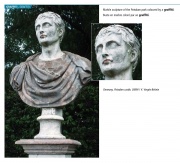Difference between revisions of "Graffiti"
| (2 intermediate revisions by the same user not shown) | |||
| Line 1: | Line 1: | ||
| − | [[File:Graffiti_ICOMOS.jpg|thumb|Graffiti]] | + | [[File:Graffiti_ICOMOS.jpg|thumb|Graffiti on park sculpture<br>Photo: V. Vergès-Belmin]] |
== Description == | == Description == | ||
| − | Any writing, drawing, or marking that is deliberately, and usually illegally, placed on private or public property. Graffiti is popularly used for commentary by political activists and for territory marks by street gangs. Although the term 'graffiti' became commonly used in the 1960s, ancient examples of defacement have been found on Egyptian monuments, Pompeian walls, and Maya temples. More recent examples include hobos marking of freight trains in the 1930s and 'Kilroy was here' graffiti placed during World War II. Currently graffiti is usually made with spray paints (e.g., Rustoleum, [[Krylon spray|Krylon]], Red Devil), chalk, or permanent markers. Graffiti removal techniques include the use of solvents (e.g., [[acetone]], [[toluene]]) and high pressure abrasives. Some anti-graffiti coatings are available that minimize paint penetration and adherence. | + | Any writing, drawing, or marking that is deliberately, and usually illegally, placed on private or public property. Graffiti is popularly used for commentary by political activists and for territory marks by street gangs. Although the term 'graffiti' became commonly used in the 1960s, ancient examples of defacement have been found on Egyptian monuments, Pompeian walls, and Maya temples. More recent examples include hobos marking of freight trains in the 1930s and 'Kilroy was here' graffiti placed during World War II. Currently graffiti is usually made with spray paints (e.g., Rustoleum, [[Krylon spray|Krylon]], [[Red Devil]]), chalk, or permanent markers. Graffiti removal techniques include the use of solvents (e.g., [[acetone]], [[toluene]]) and high pressure abrasives. Some anti-graffiti coatings are available that minimize paint penetration and adherence. |
== Synonyms and Related Terms == | == Synonyms and Related Terms == | ||
| Line 9: | Line 9: | ||
== Resources and Citations == | == Resources and Citations == | ||
| − | + | * ICOMOS-ISCS: [http://www.international.icomos.org/publications/monuments_and_sites/15/pdf/Monuments_and_Sites_15_ISCS_Glossary_Stone.pdf Illustrated glossary on stone deterioration patterns] | |
* ''Encyclopedia Britannica'', http://www.britannica.com Comment: "graffito." (Accessed 1 June 2005). | * ''Encyclopedia Britannica'', http://www.britannica.com Comment: "graffito." (Accessed 1 June 2005). | ||
Latest revision as of 09:38, 30 August 2022
Description
Any writing, drawing, or marking that is deliberately, and usually illegally, placed on private or public property. Graffiti is popularly used for commentary by political activists and for territory marks by street gangs. Although the term 'graffiti' became commonly used in the 1960s, ancient examples of defacement have been found on Egyptian monuments, Pompeian walls, and Maya temples. More recent examples include hobos marking of freight trains in the 1930s and 'Kilroy was here' graffiti placed during World War II. Currently graffiti is usually made with spray paints (e.g., Rustoleum, Krylon, Red Devil), chalk, or permanent markers. Graffiti removal techniques include the use of solvents (e.g., Acetone, Toluene) and high pressure abrasives. Some anti-graffiti coatings are available that minimize paint penetration and adherence.
Synonyms and Related Terms
graffito (singular); grafitti (sp)
Resources and Citations
- ICOMOS-ISCS: Illustrated glossary on stone deterioration patterns
- Encyclopedia Britannica, http://www.britannica.com Comment: "graffito." (Accessed 1 June 2005).
- History of Graffiti at http://www.at149st.com/ hpart1.html
- Wikipedia: http://en.wikipedia.org/wiki/Graffiti
